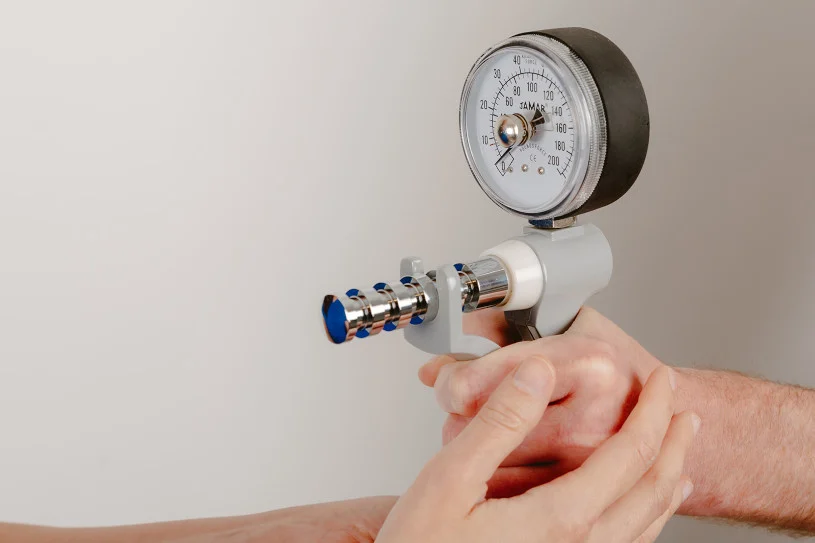
What is Hand Therapy? As Explained by an OT
What is Hand Therapy?
Hand Therapy is the assessment and treatment of any problem related to the upper limb. Hand Therapy can start within days of an injury or surgery with client-centred goals acting as a guiding cornerstone. In addition, many Hand Therapists work in conjunction with surgeons.
Hand Therapy can be provided by a registered Occupational Therapist (OT) or Physiotherapist (PT). The hand is a fraction of what a Hand Therapist can help rehabilitate. From the shoulder, upper arm, elbow, forearm or wrist – rehabilitating all of these anatomical areas falls within the remit of a Hand Therapist.
What does Hand Therapy involve?
Hand Therapy involves rehabilitating a client through conservative treatment without surgery or with post-op care. A Hand Therapist will evaluate and where applicable, differentially diagnose conditions affecting the arm or hand. Based on the Hand Therapist’s analysis and the client’s goals, a treatment plan is established. Interventions may include:
Overall, the list is quite extensive and dependent on every client’s changing needs. As you can see, Occupational Therapy and Hand Therapy link closely with one another.
What is Occupational Therapy?
Firstly, Occupational Therapy is a client-centred health profession concerned with promoting health and well being through occupation. The primary goal of Occupational Therapy is to enable people to participate in the activities of everyday life. What are occupations you say? No, it is not just your job or what you work as (although that can be part of it). In Occupational Therapy, occupations refer to the everyday activities that people do to occupy time while bringing meaning and purpose to life. Occupations include things people need to do, want to do and are expected to do. If you would like to learn more about Occupational Therapy, and how to become a registered OT, you can read more at Royal College of Occupational Theripists
I have pain, but did not have an injury. Can a Hand Therapist help?
Absolutely! Conditions affecting the arm and hand can often come about without any injury. Sometimes they can be contributed by underlying health conditions or repetitive strain. Consequently, I can assist with rehabilitation falling into the following 4 categories:
- Acquired Conditions
- Post-Trauma Aftercare
- Traumatic Surgery Aftercare
- Elective Surgery Aftercare
What are Acquired Conditions?
Acquired Conditions are diagnoses or combined issues that you develop. Common ailments include:
What kind of Post-Trauma aftercare can a Hand Therapist help with?
Firstly, trauma describes an acute injury. I can guide you with the rehabilitation you may need after a traumatic injury to your arm or hand. See my services for specialised treatments available post-trauma. Secondly, Post-Trauma Hand Therapy can involve splinting, specialty taping, manual therapy, thermal modalities and therapeutic exercise. Typical injuries can include, but are not limited to:
See my services for consultations and specialised treatments available post-trauma.
Traumatic Surgery Aftercare – I am having post-op problems after plastic surgery or orthopaedic surgery to my arm or hand. Can Hand Therapy help manage these?
Certainly! Whether you are experiencing an altered pain response or have been diagnosed with a pain related syndrome (e.g. Chronic Regional Pain Syndrome – CRPS), I can assist with getting you on the right track. Furthermore, my services also include wound care that you may require post-op and you need look no further if you have developed a hypersensitive / unsightly scar, stiffness or loss of function. As a Hand Therapist I provide treatment post-surgery for:
What is Elective Surgery and what aftercare can a Hand Therapist provide?
Elective Surgery is a planned, non-emergency surgical procedure. Many Elective Surgeries require immediate Hand Therapy input to optimise a client’s outcome. Correspondingly, this can include wound / scar care, splinting and guided exercise to optimise one’s functional result. Common procedures include:

So there you have it! An introductory demystification to Hand Therapy. As a specialised Occupational Therapist, I am truly passionate about all things relating to rehabilitating the upper limb and hand; I look forward to helping you on your journey to pain-free independence while improving your quality of life. However, are you still unsure if Hand Therapy may be right for you? Feel free to contact me and I can address your queries day or night.
I accept self-referrals as well as referrals from GP’s, specialty doctors and surgeons. No waiting lists. Just accessible Hand Therapy tailored to you. Additionally, with my virtual service there is no need to stress about traffic, public transport or the weather; consultations and treatment are only a click away no matter where you live in the UK!

